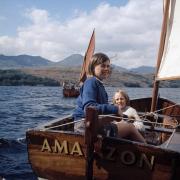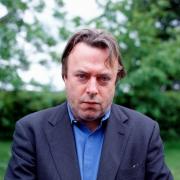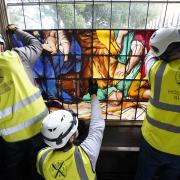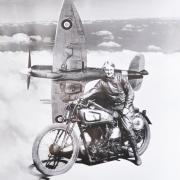Born in January 1888, the year Jack the Ripper terrorised the East End of late-Victorian London, Sir Thomas Sopwith would become an aviation pioneer who’d live to be 101 and would die having seen men among the clouds and indeed on the Moon. His last home would be in Hampshire and he’d be buried among us
Businessman, aircraft designer and sportsman, Thomas Octave Murdoch Sopwith was born in Kensington on January 18 1888. I like the middle name Octave, which suggests someone in the family was musically inclined. He was the eighth child and only son of another Thomas Sopwith, who was also a businessman, and Lydia Messiter which reminds me of Brief Encounter (1945), that iconic movie when gasbag Dolly Messiter was played by Everley Gregg.
I have no idea whether Thomas Sopwith was or was not a gasbag but he was certainly a man whose actions spoke louder than any words. If that bit of lateral thinking made you smile, well, there was nothing funny about young Thomas’ childhood, which was traumatised when he was just ten: A gun resting on his knee accidentally went off tragically killing his own father. It was a familial catastrophe that plagued Sopwith for the rest of his days. Part of his education was completed at Seafield Park Engineering College, in Hill Head, as Hampshire featured in his story for the first but certainly not the last time.
Sopwith was fascinated by all forms of transport, taking part in a motorcycle trial in 1904 and dabbling at hot air ballooning. His first ascent was with C.S. Rolls, the co-founder of Rolls-Royce, in 1906. Rolls was another aviation pioneer, who came a cropper in 1910, the first Briton dying in a powered aviation accident at the Bournemouth Centenary Airshow, Bournemouth still in Hampshire at the time. He was aged just 32. Sopwith invested in his own hot air balloon and aped Rolls by becoming a car dealer and having a go at both racing cars, including at the famous Brooklands circuit in 1906, and motorboats.
Presumably undeterred by the fate of Rolls, which must have been accepted as an occupational hazard, Sopwith learnt to fly in the same year as Rolls’ demise, 1910, and crashed on his first flight on October 22 after a journey of all of 300 yards. Within a month though he’d gained his pilot’s licence and on the same day took up his first derring-do passenger. In what remained of that same eventful year Sopwith won the Baron de Forest prize for flying across the English Channel and achieving the longest flight to the European continent thus far, reaching eastern Belgium (Louis Blériot, the Frenchman, having completed the first cross-Channel flight in 1909). He then founded the Sopwith Aviation Company at Kingston-upon-Thames in 1912 and promptly won the first aerial derby, funnily enough piloting a Blériot monoplane.

Apparently, in the same year, he became the first pilot to drop a mail package on to the deck of a ship, in New York Harbour. Sopwith’s company would lift the Schneider Trophy, the famous seaplane racing competition, in 1914, having already worked with the Saunders Boatyard in Southampton to develop the Sopwith Bat-Boat for the fledgling Royal Naval Air Service (RNAS which would become a part of the newly formed RAF in 1918.
It was at Sopwith’s own aviation company in Kinston-Upon-Thames where he would design and build many of the aeroplanes used for reconnaissance and dog fights in WW1 including the iconic Sopwith Camel which was as revered then as the Spitfire and Hurricane would be in the next conflict, being undoubtedly the most famous British fighter aircraft of the Great War, which brought down nearly 1,300 enemy aircraft. Probably Sopwith’s greatest ever aircraft design it featured machine guns synchronised to fire through a revolving propellor, which made the single-seater fighter a viable proposition.
There was also the Pup, Triplane and 1½-Strutter. He’d become a C.B.E. in 1918 for services to the war effort after some 16,000 Sopwith-designed aircraft had been turned out with over 5,000 people employed by the company. He’d also be bankrupted though thanks to a government demand for a tax on excess war profits. Sopwith was no quitter though and made a spectacular comeback, becoming chairman of the Society of British Aircraft Constructors (1925-27).
He was also a keen sportsman, a yachtsman who challenged for the America’s Cup in the 1930s, as well as competing in ice hockey, being good enough to represent the British national side. Those America’s Cup challenges featured the yachts Endeavour (1934) and Endeavour II (1937), neither of which was able to wrest the cup away from the incumbent Americans who harboured it like a family heirloom. He came closest when representing the Royal Yacht Squadron in 1934, defeated 4-2 by Harold S. Vanderbilt’s Rainbow.
Sopwith was chairman of the Hawker Siddeley Manufacturing Group from 1935 and its president from 1963 and had a hand in legendary planes of both world wars as it was on his watch that the Hurricane, one of the fighters that helped turn the tide in the Battle of Britain, was developed. Although the Spitfire has become the romantic legend of the Battle of Britain it was the Hurricane that actually accounted for over 60% of the enemy aircraft shot down during that summer of 1940. The group churned out almost 15,000 Hurricanes between 1937 and 1944 with a grand total of some 40,000 military aircraft built during the war years alone. In 1941 Hawker Siddeley also developed the first British jet engine, the Meteor, the only Allied jet flown operationally during WW2 which played a key role in combating the German V1 Doodlebug flying bomb. Avro, the manufacturer of the Lancaster, merged into Hawker Siddeley in the year that Sopwith became its president and he was knighted in 1953.
Thomas Sopwith retired at the venerable age of 90 in 1978. When he attained a century a decade later, the milestone was celebrated with a flypast of military aircraft over his home, Compton Manor, in King’s Somborne, near Winchester. The Sopwiths had bought Compton Manor, a grand house of the Victorian era, at the end of the Second World War in 1945. When Sopwith died at home a year after that flypast, on January 27 1989, Compton Manor comprised 2,175 acres. He’d celebrated his 101st birthday just over a week before. Sopwith’s grave lies in the churchyard of All Saints, Little Somborne. It’s a simple headstone which records him as a ‘pioneer aviator’.

Chronology
1888 – Birth of Thomas Octave Murdoch Sopwith, Kensington, London (January 18).
1910 – Sopwith gains his pilot’s licence and wins the Baron de Forest prize.
1912 – Founds Sopwith Aviation Company which would play a key role during WW1.
1914 – Marries Beatrix Hore-Ruthven (until her death in 1930) and wins Schneider Trophy.
1918 – Sopwith is made a CBE for his services to the war effort but also faces bankruptcy.
1932 – Marries Phyllis Brodie (until her death in 1978).
1934 – Sopwith’s first challenge for the America’s Cup with Endeavour.
1937 – Hawker Siddeley’s Hurricane fighter enters RAF squadron service.
1989 – Death of Sir Thomas Sopwith in Hampshire (January 27) aged 101.



























